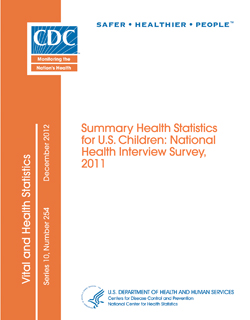Children’s dental visits, unmet need
Data from 2011 National Health Interview Survey
 |
Hyattsville, Md.—More than 4 million children aged 17 and younger had unmet dental need in 2011 because their families could not afford dental care, the National Center for Health Statistics said in an analysis of data collected annually by U.S. Census Bureau interviewers.
The estimated number and percentage of U.S. children with unmet dental need are roughly comparable, though slightly less, than indicated by the 2010 National Health Interview Survey, a multistage probability sample survey representative of the civilian noninstitutionalized population.
In 2011, most U.S. children under age 18 years, 83 percent, had excellent or very good health, according to the NCHS analysis. However, 7 percent of children had no health insurance coverage, 3 percent had no usual place of health care and 6 percent had unmet dental need, the report said. Estimates are presented for asthma, allergies, learning disability, attention deficit hyperactivity disorder (ADHD), prescription medication use for at least three months, school days missed due to illness or injury, usual place of health care, time since last contact with a health care professional, selected measures of health care access, emergency room visits in the past 12 months, and dental care.
The measure of unmet dental need is based on responses to the question posed during interviews with adult family respondents in more than 40,000 families, “DURING THE PAST 12 MONTHS, was there any time when (child’s name) needed any of the following but didn’t get it because you couldn’t afford it. Dental care including (check-ups)?”
Children in single-mother families were more likely to have unmet dental need (8 percent) than those in two-parent families (6 percent), said the Summary Health Statistics for U.S. Children: National Health Interview Survey, 2011 report. Uninsured children (22 percent) were more than four times as likely to have unmet dental need as children with private health insurance (5 percent) and more than three times as likely as children with Medicaid or other public coverage (6 percent).
Interviewers also asked, “About how long has it been since anyone in the family last saw a dentist? Include all types of dentists, such as orthodontists, oral surgeons and all other dental specialists, as well as dental hygienists.”
Non-Hispanic white children were more likely to have had a dental visit in the past 6 months (67 percent) than non-Hispanic black (60 percent) and Hispanic (61 percent) children. Twenty-seven percent of uninsured children had no dental visit for more than two years, including those who have never seen a dentist, compared with 12 percent of children with Medicaid and 10 percent of children with private health insurance, the report said.
The children’s health report (Vital and Health Statistics Series 10, Number 254) and reports on selected health measures for the U.S. population and for adults summarize data from the 2011 National Health Interview Survey. These reports are published by the Centers for Disease Control and Prevention’s National Center for Health Statistics.
